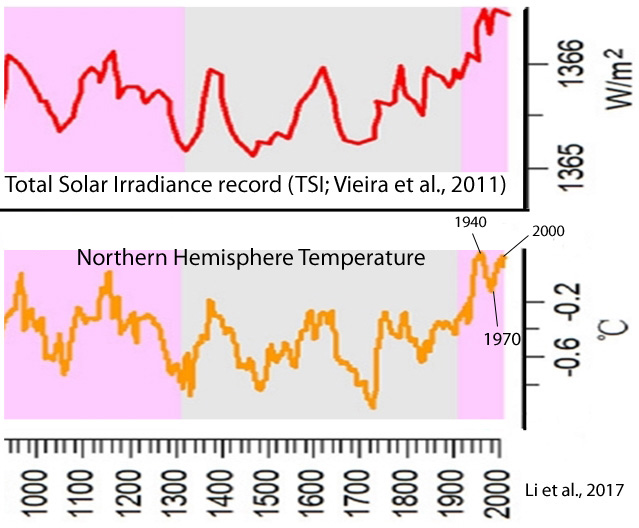
One of the oft-stated “truths” for advocates of the position that humans are predominantly responsible for climate changes is that the Sun could not have played more than a negligible role in the global warming of the last few centuries. Indeed, the latest Intergovernmental Panel on Climate Change (IPPC) report theorizes that the long-term solar contribution to climate change has been slightly above zero.
IPCC AR5:
And yet today’s scientists have not been deterred in their quest to document a robust Sun-Climate link in the paleoclimate data… as well as in the temperature and climatic changes for recent decades. In 2016 alone, for example, there were over 130 scientific papers documenting a non-negligible solar influence on climate.
Climate scientist Dr. Jianyong Li, who has himself authored over 300 peer-reviewed scientific publications, continues this trend of linking climate changes to solar forcing. He and 13 other scientists just published a new paper in the journal Quaternary Science Reviews in which they have clearly affirmed the dominance of the Sun’s forcing on the climate of China (and for the Northern Hemisphere in general) during the past few thousand years, including the last century. The authors assert that climate changes and solar activity are well correlated throughout the paleoclimate record, and that if there is a role for greenhouse gases to influence climatic trends, that role is merely supplementary, not dominant. They also describe in detail how the Sun’s variance acts to influence atmospheric and oceanic heat oscillations, and how this may affect regional precipitation, weather, and temperature changes.
Li et al., 2017
Summary
“We suggest that solar activity may play a key role in driving the climatic fluctuations in NC [North China] during the last 22 centuries, with its quasi ∼100, 50, 23, or 22-year periodicity clearly identified in our climatic reconstructions. … It has been widely suggested from both climate modeling and observation data that solar activity plays a key role in driving late Holocene climatic fluctuations by triggering global temperature variability and atmospheric dynamical circulation (e.g., Haigh, 1996; Shindell et al., 1999; Bond et al., 2001; Fleitmann et al., 2003; Dykoski et al., 2005).”
Climate Changes/Oscillations And Solar Activity Well Correlated For North China, Northern Hemisphere
“Spectral analyses indicate that the PANN [annual precipitation] record has significant periodicities at 100, 67, 57 and 23 years; and the TANN [annual temperature] record displays notable periodicities at 118, 103, 80, 67, 56, 50, 40 and 22 years (Fig. 4). The 100, 57 and 23 year periods for PANN, as well as the 103, 50, and 22 year periods for TANN, correlate well with the 100, 50, 23 and 22 year cycles for the solar activity observed in various solar parameters (e.g., Wilson et al., 1996; Li et al., 1996; Chowdhury et al., 2009; Zhang et al., 2014), therefore implying an in-phase relationship between the climatic oscillation in NC [North China] and solar activity. Furthermore, a multidecadal to centennial comparison of our pollen-derived TANN reconstruction for NC with the Total Solar Irradiance (TSI; Vieira et al., 2011), the Asian Pacific Oscillation index (APO; Zhou et al., 2009), the Intertropical Convergence Zone index (ITCZ; Haug et al., 2001), the North Atlantic Oscillation index (NAO; Trouet et al., 2009; Olsen et al., 2012) and the Ice-Rafted Debris record (IRD; Bond et al., 2001) from the North Atlantic Ocean, suggests a strong underlying teleconnection between the EAM [East Asian Monsoon] regime in NC and many other high- or low-latitude climatic systems in different regions of the northern Hemisphere.”
[Notice there has been no significant net warming in North China since about 1950, consistent with the temperature trends for the Northern Hemisphere in general and similar to the identified pattern in reconstructions of Total Solar Irradiance.]
The Mechanism Of Solar Forcing And Climatic/Oscillatory Changes
“In short, the mechanism of the climatic variations in NC [North China] can be likely summarized as follows. The strengthened solar activity could be significantly amplified by the variations in ultraviolet radiation as well as clouds (e.g., Haigh, 1996; Tinsley, 2000), resulting in the marked variability in global surface temperature. As the heat capacity between land and ocean differs notably, if TSI increases, the thermal contrast between the East Asian continent and the North Pacific Ocean would be enhanced, resulting in high values of APO and thus northward shift of both ITCZ and Western Pacific Subtropical High (WPSH) positions (e.g., Zhao et al., 2007; Zhou et al., 2009), so that the summer monsoon and its rain belt would move further north and stay longer in NC. At the same time, because the increased TSI would lead to decreased IRD values, but increased North Atlantic Deep Water (NADW) circulation, and hence a positive NAO phase, the EAM continent including NC would receive less cold air masses from the high-latitude regions of NH and thus be substantially warming up, so that the winter monsoon and westerlies would be concurrently weakened and retreat northward (e.g., Wu and Wang, 2002; Wang et al., 2005; Li et al., 2015a). As a result, the enhanced summer monsoon would bring more rainfall to NC where the surface temperature is also synchronously higher. In contrast, when TSI declines, the EAM land temperature falls quickly, whereas the winter monsoon and westerlies would be intensified, thus leading to increased IRD values, but declining NADW strength as well as a negative NAO phase; and meanwhile the positions of both ITCZ and WPSH would retreat southward, the summer monsoon intensity would be significantly weakened, thereby resulting in the coincidently decreased precipitation as well as temperature in NC.”
CO2 May ‘Partly’ Affect Climate Variations, But Its Role Is Only Superimposed On ‘Solar-Dominated Control’
“Additionally, increased El Nino-Southern Oscillation (ENSO) strength (possibly El Niño-like phases) during drying periods, increased volcanic eruptions and the resulting aerosol load during cooling periods, as well as high volumes of greenhouse gases such as CO2 and CH4 during the recent warming periods, may also play a role in partly affecting the climatic variability in NC, superimposing on the overall solar-dominated long-term control (e.g., Wanner et al., 2008; Tan et al., 2011; Kobashi et al., 2013; Chen et al., 2015a,b).”
A Closer Look At The Robust Correlation Between Solar Variability And Modern Climate
In examining the strong correlation between solar variability and temperature changes, notice the reconstruction of Total Solar Irradiance (TSI) supplied in the Li et al. (2017) paper (from Vieira et al., 2011, shown in this article’s leading graph above and now below). TSI trends for the last several centuries indicate a dramatic rise in solar irradiance from the early 20th century until about 1950, then a decline in solar forcing through the 1960s and 1970s, and then another rising TSI trend after the 1980s until the early 2000s. These trends all correlate rather well with temperature trends not only for China, but for the entire Northern Hemisphere.
Vieira et al., 2011
Even using non-tampered-with instrumental temperature datasets reveal a similar warming-cooling-warming oscillation for the Northern Hemisphere that is compatible with reconstructions of TSI.
Prior to NASA’s elimination of 0.45°C of warming from the 1880s to 1940 period, as well as making 0.3°C of cooling disappear from the 1940 to 1970 trend, the National Academy of Sciences produced a graph (depicted below) indicating there was nearly 1°C of warming between the late 1880s and 1940, and then about -0.5 or -0.6°C of cooling between 1940 and 1975.
And then, since 1979, the RSS sattellite temperature dataset (shown below) indicates that the Northern Hemisphere (NH) has warmed again by about +0.5 or +0.6° C overall since the 1970s, likely recovering completely from the earlier cooling period of similar magnitude (1940 to 1970s). Since about 2000, the NH trend has been largely flat (until the 2015-’16 Super El Niño warming event). Therefore, using the instrumental records that have likely not been massively adjusted to fit climate models, the 1940s peak and the 2000s plateau are probably similar in warming magnitude. So, like the paleoclimate reconstructions shown above from Li et al. (2017), even the instrumental record seems to correlate well with the Vieira et al. (2011) TSI reconstruction for the 20th and 21st centuries.
RSS Satellite Graph Climate4you
Because large regions of the Southern Hemisphere (and middle latitudes) have not warmed since the 1970s (regions such as West Antarctica, East Antarctica, Antarctica as a whole, the Southern Ocean, South America, Australia, India, the Indian Ocean …) even global surface temperatures may follow a warming-cooling-warming oscillatory pattern for the 20th century that correlates well with TSI trends.
Gerhard, 2004
A 2014 Paper Also Affirms A Robust Correlation Between TSI And Temperatures
“There were several centennial-scale fluctuations in the climate and oceanography of the North Atlantic region over the past 1,000 years, including a period of relative cooling from about AD 1450 to 1850 known as the Little Ice Age. These variations may be linked to changes in solar irradiance, amplified through feedbacks including the Atlantic meridional overturning circulation. … The reconstructed centennial-scale variations in hydrography correlate with variability in total solar irradiance. We find a similar correlation in a simulation of climate over the past 1,000 years. [L]ow solar irradiance promotes the development of frequent and persistent atmospheric blocking events, in which a quasi-stationary high-pressure system in the eastern North Atlantic modifies the flow of the westerly winds. … Our results reveal abrupt multidecadal to centennial shifts in the temperature and salinity of the NAC [North Atlantic Current] waters of ∼3.5 °C and ∼1.2 °C, respectively, during the past millennium. The magnitude of the hydrographic variability is substantial and comparable to that recorded in a lower resolution record spanning the present interglacial from a nearby site, which highlights the similarities in the ocean variability on a diverse range of timescales. The timing of the hydrographic shifts shows a strong correlation with total solar irradiance (TSI) variability. Periods of solar minima (maxima) generally correspond to cold and fresh (warm and salty) conditions in the NAC.”
Conclusion
The IPCC has taken the position that the Sun (and natural factors like clouds and aerosols that influence its variable surface energy absorption) has had little to no influence on climate changes in the last few hundred years. This conceptualization is rooted in the presupposition that humans are primarily — if not exclusively — responsible for Earth’s temperature changes. Media outlets have taken the cue and headlined stories such as “2016 Was Earth’s Hottest Year on Record, and Humans Are to Blame“.
Considering the large and growing body of scientific evidence linking the Sun to climate variations — even for the 20th and 21st centuries — it is long past due for the IPCC and other influential bodies to take a much closer look at the solar sciences as an explanation for past and present climate changes.
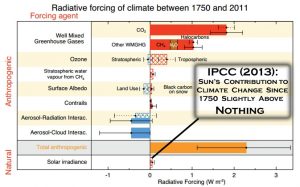
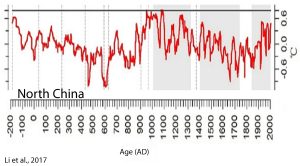
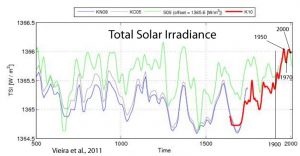
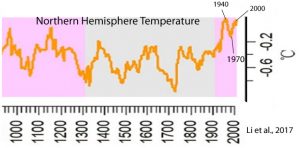
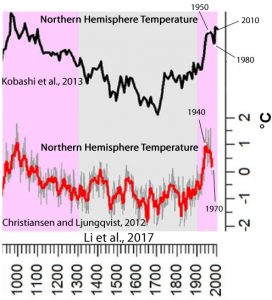
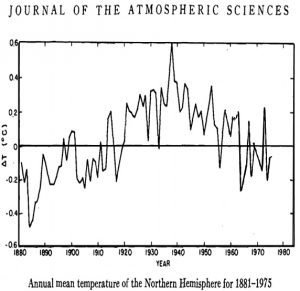
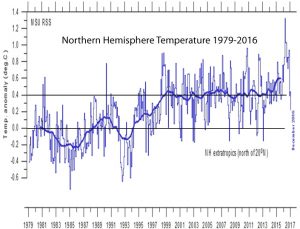
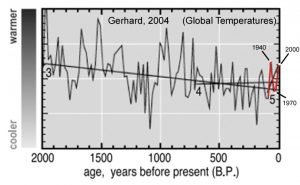
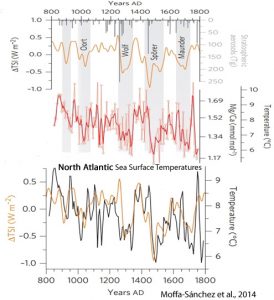





There are some very, very smart people in China – and that has always been the case.
But, then you have TV scientists who say ignore any new results, all is settled. I say, if it is all settled, defund their science programs, there is no need for them to investigate anymore.
[…] Data Tampering Uncovered At NASA? The subject was recently discussed at NTZ (and illustrated with multiple graphs). With regard to two events they indicate simultaneously the […]
Awesome research, I had to look up Irradiance and found several different applications for the measure but now see its application here. I hope the new free government in the US will allow the MSM to publish.
A couple of months ago I read an fascinating novel that deals with the climate change issues, but present them in a unique outlook into the future.
For those that find the subject interesting, yet somewhat a dull reading, take a look at “Shield of Life” by Dan F.
I think that you’ll enjoy it.
What is amazing in the final graphic is how the minimums (Oort, Wolf, Sporer, Maunder) rapidity of the speed of change, both going into a freeze and the exit in to warmer times.
Wolf and Sporer are particularly worrisome in showing just how rapid the cooling came to both air and sea.
Meanwhile
“Ice on Danube River 4 meters thick at Dalj Bend
Ice on the Danube at the so-called Dalj Bend is four meters thick, says MUP Emergency Situations Sector chief Predrag Matic.”
More icebreakers are on there way to attempt to get the river’s ice cleared and to reopen the river to navigation all the way to Belgrade.
http://www.b92.net/eng/news/society.php?yyyy=2017&mm=01&dd=19&nav_id=100277
Hungerian icebreakers at work on the Danube:
http://www.b92.net/eng/news/society.php?yyyy=2017&mm=01&dd=17&nav_id=100257
Here’s the river I wrote about in my other post (may not be up yet), and in the same location.
http://www.dailymail.co.uk/news/article-2537831/Dont-winter-clothes-away-just-ANOTHER-Polar-Vortex-expected-hit-U-S-week.html
The one I saw was years before that one.
It’s nowhere near as bad as the Danube in your link, but the same type of thing – an ice jam if it’s just on the surface, or ice dam if it blocks the river and makes it flood.
paper mentions sun and climate. So sun is the only cause of climate change.
another paper mentions fish and yoghurt. So fish eat only yoghurt.
Instead of making up your own version of what was written in the paper, why not use the actual words of the scientists themselves?
–
“It has been widely suggested from both climate modeling and observation data that solar activity plays a key role in driving late Holocene climatic fluctuations by triggering global temperature variability and atmospheric dynamical circulation.”
–
“[T]he 103, 50, and 22 year periods for TANN [annual temperature] correlate well with the 100, 50, 23 and 22 year cycles for the solar activity observed in various solar parameters (e.g., Wilson et al., 1996; Li et al., 1996; Chowdhury et al., 2009; Zhang et al., 2014), therefore implying an in-phase relationship between the climatic oscillation in NC [North China] and solar activity.”
–
“The strengthened solar activity could be significantly amplified by the variations in ultraviolet radiation as well as clouds (e.g., Haigh, 1996; Tinsley, 2000), resulting in the marked variability in global surface temperature.”
–
“[H]igh volumes of greenhouse gases such as CO2 and CH4 during the recent warming periods may also play a role in partly affecting the climatic variability in NC, superimposing on the overall solar-dominated long-term control (e.g., Wanner et al., 2008; Tan et al., 2011; Kobashi et al., 2013; Chen et al., 2015a,b).”
Yes sod and your UN style logic is unconvincing.
The UN model asserts (with no observed evidence) that CO2 causes warming.
In contrast the paper you criticize asserts that modeled solar effects are based on observed effects and therefore can be falsified if the observation show so.
“In 2016 alone, for example, there were over 130 scientific papers documenting a non-negligible solar influence on climate.”
sop.. the word climate change is a very stupid word. Climate has always changed, and there is absolutely no evidence that it is changing any more than it always has.
Yes the strong solar cycles of the latter part of last century probably caused the small amount of warming that manifested itself at the 1998 El Nino event.. (there has been no warming apart from that El Nino step)
Certainly CO2 has absolutely NOTHING to do with normal changes in climate or beneficial planetary warming from the LIA..
There is absolutely NO mechanism that allows for CO2 warming of a convective atmosphere,
There is no CO2 warming signal in either satellite temperature data set
No acceleration of sea level rise.
NO CO2 SIGNAL anywhere. !!
(except in the “adjustments™” to surface data)
A chink in the ‘warming armour’ ?
[…] New Paper: 14 Scientists Affirm Solar Forcing, Not CO2, Is ‚Dominant Control“ For Modern… […]
The chart you have for Ljungqvist 2010 does NOT appear anywhere in that paper. Please correct.
From Fig. 3, pg. 39:
“(e-g) the three integrated temperature anomaly series (TA-1-3) for northern Hemisphere (NH) (Ljungqvist, 2010 [e]; Christiansen and Ljungqvist, 2012 [f]; Kobashi et al., 2013)[g]”
References:
Ljungqvist, F.C., 2010. A new reconstruction of temperature variability in the extratropical northern hemisphere during the last two millennia. Geogr. Geogr. Ann. A 92, 339-351
Chart doesnt match anything in Ljungqvist 2010: http://agbjarn.blog.is/users/fa/agbjarn/files/ljungquist-temp-reconstruction-2000-years.pdf
Then I wonder if it is possible Li and co-authors erroneously transposed their attribution for Ljungqvist, 2010 and Kobashi et al., 2013. Because the graphic of NH temperatures is clearly shown to be (e), and the graph description has the attribution order as:
“(e-g) the three integrated temperature anomaly series (TA-1-3) for northern Hemisphere (NH) (Ljungqvist, 2010 [e]; Christiansen and Ljungqvist, 2012 [f]; Kobashi et al., 2013)[g]”
[…] Research). Figure 1. Figure 2. Figure 3. Figure 4. Comments will take a few seconds to appear. New Paper: 14 Scientists Affirm Solar Forcing, Not CO2, Is ‘Dominant Control’ For Modern Climate…. One of the oft-stated “truths” for advocates of the position that humans are predominantly […]
[…] National Academy of Sciences graph 1°C of warming between the late 1880s and 1940 https://notrickszone.com/2017/01/23/ne… Whistleblower: NOAA Scientists Manipulated Temperature Data To Make Global Warming Seem Worse […]